Investigation of Temperature Variations and Extreme Temperature Differences for the Corrugated Web Steel Beams under Solar Radiation
Abstract
:1. Introduction
2. Experimental Procedures
3. The Experimental Results
3.1. Air Temperature, Wind Speed, and Solar Radiation
3.2. Vertical Temperature Distributions
3.3. Maximum and Minimum Temperatures
4. Finite Element Model of the Steel Beam
4.1. Basic Theory for Thermal Analysis
4.2. Finite Element Model
4.3. Model Validation
5. Long-Term Environmental Data
Environmental Data
6. Results of the Long-Term Simulation
7. Extreme Value Analysis for Thermal Gradient
7.1. Extreme Value Analysis
7.2. GEV Distribution and Extreme Temperature Difference
8. Conclusions
- (1)
- The selected three cross-sections were subjected to different thermal loadings, demonstrating different temperature distributions. The magnitude of the web’s temperature at Section-C was highest, followed by that at Section-M and Section-T, respectively. The maximum vertical temperature gradient at Section-T, Section-M, and Section-C reached up to 10.5 °C, 10.2 °C, and 8.8 °C, respectively. The experimental results demonstrate that the steel beam has a complicated and non-uniform temperature field.
- (2)
- The numerical simulation method was proposed for the thermal analysis and its accuracy was verified by the experimental temperature data. The MAE of the thermometers located at Section-T, Section-M, and Section-C are 3.5 °C, 3.8 °C, and 4.1 °C, respectively. On the other hand, the AAE of the thermometers located at Section-T, Section-M, and Section-C are 1.1 °C, 1.1 °C, and 1.0 °C, respectively.
- (3)
- The long-term variations of steel beams’ daily maximum temperature, daily minimum temperature, and the daily temperature difference regarding different regions were provided. The extreme value of the daily maximum temperature of the steel beam in Turpan reached up to 70.1 °C on 4 July 2019, while the extreme value of the daily minimum temperature of the steel beam in Naqu dropped to as low as −27.0 °C on 24 January 2020. The extreme daily temperature changes of the steel beam in Harbin reached up to 46.7 °C.
- (4)
- The representative values of steel beams’ daily temperature difference with a 50-year return period were determined with an extreme value analysis. All the daily temperature differences in relation to the eight cities studied fit well with the Weibull distribution. The representative values of steel beams’ daily temperature differences in Harbin, Changsha, Jinan, Shanghai, Haikou, Kunming, Naqu, and Turpan are 46.9 °C, 40.8 °C, 41.9 °C, 33.3 °C, 28.8 °C, 42.6 °C, 44.4 °C, and 41.7 °C, respectively.
Author Contributions
Funding
Institutional Review Board Statement
Informed Consent Statement
Data Availability Statement
Acknowledgments
Conflicts of Interest
References
- Chen, D.; Qian, H.; Wang, H.; Chen, Y.; Fan, F.; Shen, S. Experimental and numerical investigation on the non-uniform temperature distribution of thin-walled steel members under solar radiation. Thin-Walled Struct. 2018, 122, 242–251. [Google Scholar] [CrossRef]
- Lei, X.; Fan, X.; Jiang, H.; Zhu, K.; Zhan, H. Temperature field boundary conditions and lateral temperature gradient effect on a PC box-girder bridge based on real-time solar radiation and spatial temperature monitoring. Sensors 2020, 18, 5261. [Google Scholar] [CrossRef] [PubMed]
- Chen, D.; Wang, H.; Qian, H.; Li, X.; Fan, F.; Shen, S. Experimental and numerical investigation of temperature effects on steel members due to solar radiation. Appl. Therm. Eng. 2017, 127, 696–704. [Google Scholar] [CrossRef]
- Nikoomanesh, M.R.; Goudarzi, M.A. Patch loading capacity for sinusoidal corrugated web girders. Thin-Walled Struct. 2021, 167, 108445. [Google Scholar] [CrossRef]
- Leblouba, M.; Junaid, M.T.; Barakat, S.; Altoubat, S.; Maalej, M. Shear buckling and stress distribution in trapezoidal web corrugated steel beams. Thin-Walled Struct. 2017, 113, 13–26. [Google Scholar] [CrossRef]
- Huang, S.; Cai, C.; He, X.; Zhou, T.; Zou, Y.; Liu, Q. Experimental and numerical investigation on the non-uniform temperature distribution of steel beams with corrugated web under solar radiation. J. Constr. Steel Res. 2022, 191, 107174. [Google Scholar] [CrossRef]
- Wang, Y.; Zhan, Y.; Zhao, R. Analysis of thermal behavior on concrete box-girder arch bridges under convection and solar radiation. Adv. Struct. Eng. 2016, 19, 1043–1059. [Google Scholar] [CrossRef]
- Zhang, C.; Liu, Y.; Liu, J.; Yuan, Z.; Zhang, G.; Ma, Z. Validation of long-term temperature simulations in a steel-concrete composite girder. Structures 2020, 27, 1962–1976. [Google Scholar] [CrossRef]
- Zhao, Z.; Liu, H.; Chen, Z. Field monitoring and numerical analysis of thermal behavior of large span steel structures under solar radiation. Adv. Steel Constr. 2017, 13, 190–205. [Google Scholar]
- Liu, H.; Liao, X.; Chen, Z.; Zhang, Q. Thermal behavior of spatial structures under solar irradiation. Appl. Therm. Eng. 2015, 87, 328–335. [Google Scholar] [CrossRef]
- Luo, Y.; Mei, Y.; Shen, Y.; Yang, P.; Jin, L.; Zhang, P. Field measurement of temperature and stress on steel structure of the National Stadium and analysis of temperature action. J. Build. Struct. 2013, 34, 24–32. [Google Scholar]
- Zhao, Z.; Liu, H.; Chen, Z. Thermal behavior of large-span reticulated domes covered by ETFT membrane roofs under solar radiation. Thin-Walled Struct. 2017, 115, 1–11. [Google Scholar] [CrossRef]
- Chen, D.; Xu, W.; Qian, H.; Wang, H. Thermal behavior of beam string structure: Experimental study and numerical analysis. J. Build. Eng. 2021, 40, 102724. [Google Scholar] [CrossRef]
- Chen, D.; Xu, W.; Qian, H.; Sun, J.; Li, J. Effects of non-uniform temperature on closure construction of spatial truss structure. J. Build. Eng. 2020, 32, 101532. [Google Scholar] [CrossRef]
- Abid, S.R. Temperature variation in steel beams subjected to thermal loads. Steel Compos. Struct. 2020, 34, 819–835. [Google Scholar]
- Liu, H.; Chen, Z.; Zhou, T. Theoretical and experimental study on the temperature distribution of H-shaped steel members under solar radiation. Appl. Therm. Eng. 2012, 37, 329–335. [Google Scholar] [CrossRef]
- Liu, H.; Chen, Z.; Han, Q.; Chen, B.; Bu, Y. Study on the thermal behavior of aluminum reticulated shell structures considering solar radiation. Thin-Walled Struct. 2014, 885, 15–24. [Google Scholar] [CrossRef]
- Kim, S.H.; Park, S.J.; Wu, J.; Won, J.H. Temperature variation in steel box girders of cable-stayed bridges during construction. J. Constr. Steel Res. 2015, 112, 80–92. [Google Scholar] [CrossRef]
- Liu, H.; Chen, Z.; Zhou, T. Numerical and experimental investigation on the temperature distribution of steel tubes under solar radiation. Struct. Eng. Mech. 2012, 43, 725–737. [Google Scholar] [CrossRef]
- Gregory, N.; Sanford, K. Heat Transfer; Cambridge University Press: Cambridge, UK, 2008. [Google Scholar]
- Cai, C.; Huang, S.; He, X.; Zhou, T.; Zou, Y. Investigation of concrete box girder positive temperature gradient patterns considering different climatic regions. Structures 2022, 35, 591–607. [Google Scholar] [CrossRef]
- Numan, H.A.; Tayşi, N.; Özakça, M. Experimental and finite element parametric investigations of the thermal behavior of CBGB. Steel Compos. Struct. 2016, 20, 813–832. [Google Scholar] [CrossRef]
- Abid, S.R.; Tayşi, N.; Özakça, M.; Xue, J.; Briseghella, B. Finite element thermo-mechanical analysis of concrete box-girders. Structures 2021, 33, 2424–2444. [Google Scholar] [CrossRef]
- Liu, H.; Chen, Z.; Chen, B.; Xiao, X.; Wang, X. Studies on the temperature distribution of steel plates with different paints under solar radiation. Appl. Therm. Eng. 2014, 71, 342–354. [Google Scholar] [CrossRef]
- Lee, J.H. Experimental and Analytical Investigations of the Thermal Behavior of Prestressed Concrete Bridge Girders Including Imperfections. Ph.D. Thesis, Georgia Institute of Technology, Atlanta, GA, USA, 2021. [Google Scholar]
- Liu, B.Y.H.; Jordan, R.C. The long-term average performance of flat-plate solar energy collectors. Sol. Energy 1963, 7, 53–74. [Google Scholar] [CrossRef]
- Abid, S.; Tayşi, N. Temperature distributions and variations in concrete box-girder bridges: Experimental and finite element parametric studies. Adv. Struct. Eng. 2015, 18, 469–487. [Google Scholar]
- COMSOL Multiphysics v 4.3a. In COMSOL Multiphysics User’s Guide; COMSOL: Stockholm, Sweden, 2012.
- Gao, F.; Chen, P.; Xia, Y.; Zhu, H.P.; Weng, S. Efficient calculation and monitoring of temperature actions on supertall structures. Eng. Struct. 2019, 193, 1–11. [Google Scholar] [CrossRef]
- Kreith, F.; Kreider, J.F. Principles of Solar Engineering; Macmillan: New York, NY, USA, 2015. [Google Scholar]
- Liu, C. The Temperature Field and Thermal Effect of Steel-Concrete Composite Bridges. Ph.D. Thesis, Tsinghua University, Beijing, China, 2018. (In Chinese). [Google Scholar]
- Tian, Y.; Zhang, N.; Xia, H. Temperature effect on service performance of high-speed railway concrete bridges. Adv. Struct. Eng. 2017, 20, 865–883. [Google Scholar] [CrossRef]
- Dilger, W.H.; Ghali, A.; Chan, M.; Cheung, M.S.; Maes, M.A. Temperature stress in composite box girder bridges. J. Struct. Eng. 1983, 109, 1460–1479. [Google Scholar] [CrossRef]
- Elbadry, M.M.; Ghali, A. Temperature variations in concrete bridges. J. Struct. Eng. 1983, 109, 2355–2374. [Google Scholar] [CrossRef]
- Liu, J.; Liu, Y.; Zhang, G. Experimental analysis of temperature gradient patterns of concrete-filled steel tubular members. J. Bridge Eng. 2019, 24, 04019109. [Google Scholar] [CrossRef]
- Makkonen, L. Problems in the extreme value analysis. Struct. Saf. 2008, 30, 405–419. [Google Scholar] [CrossRef]

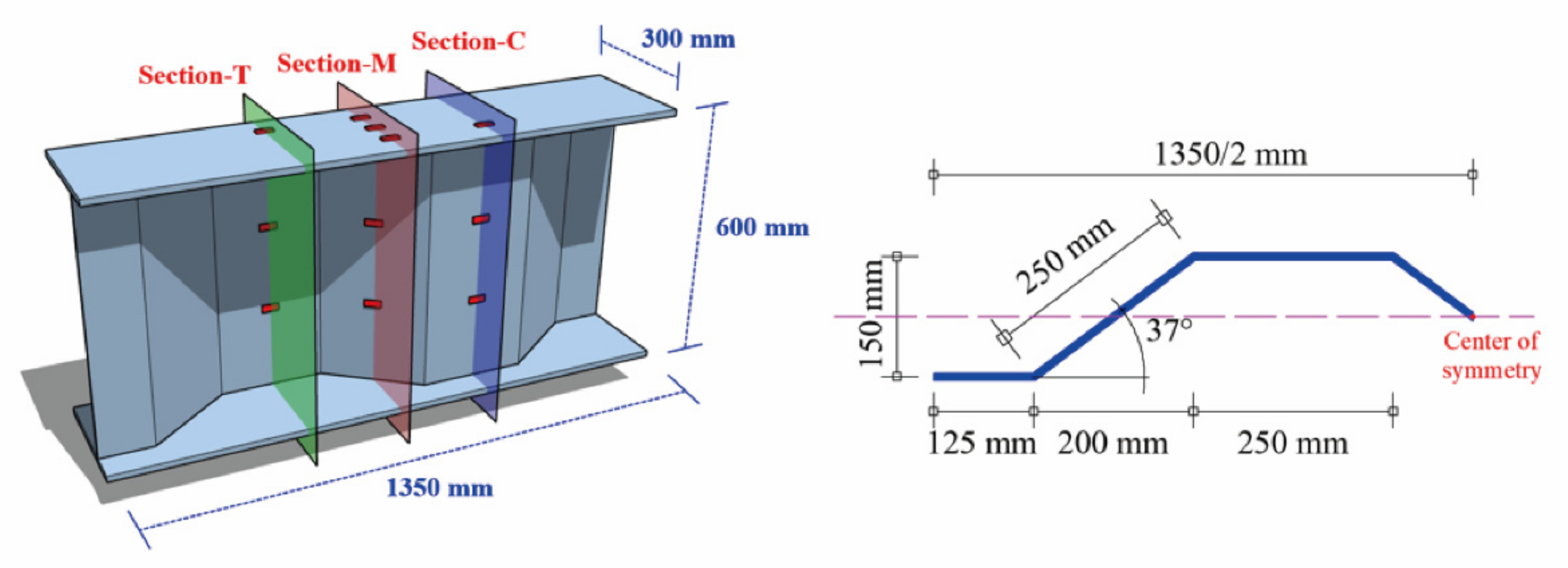

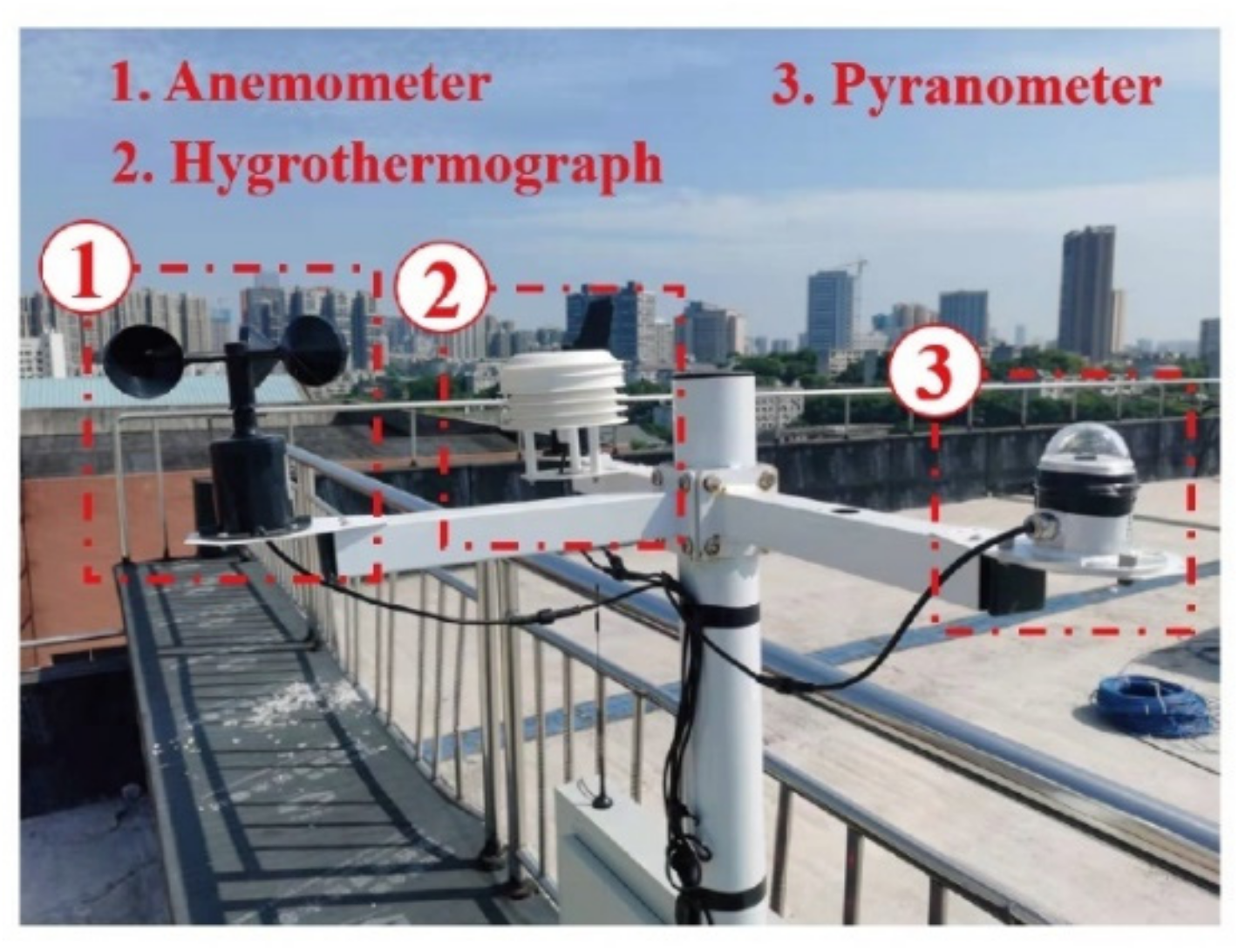


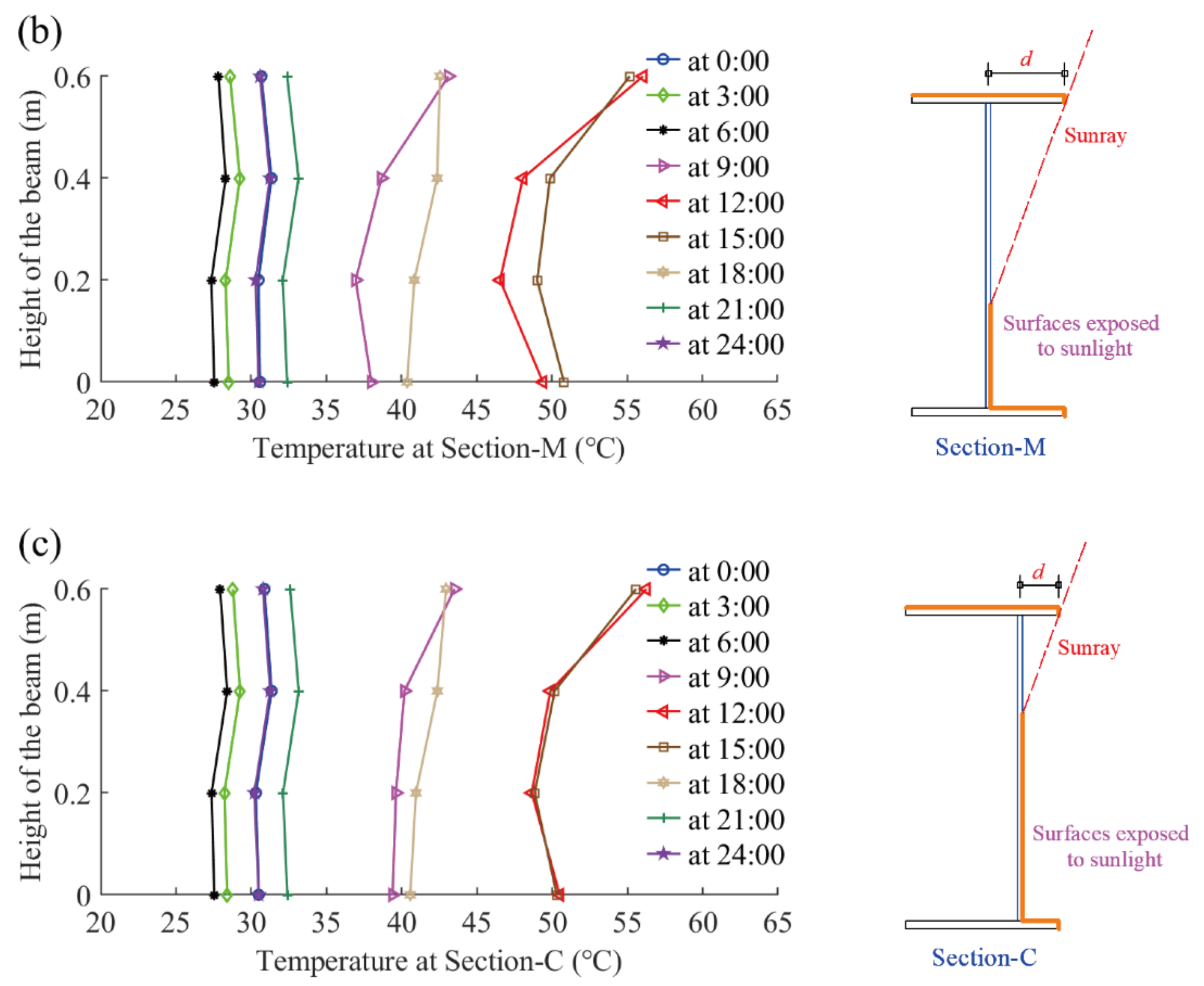

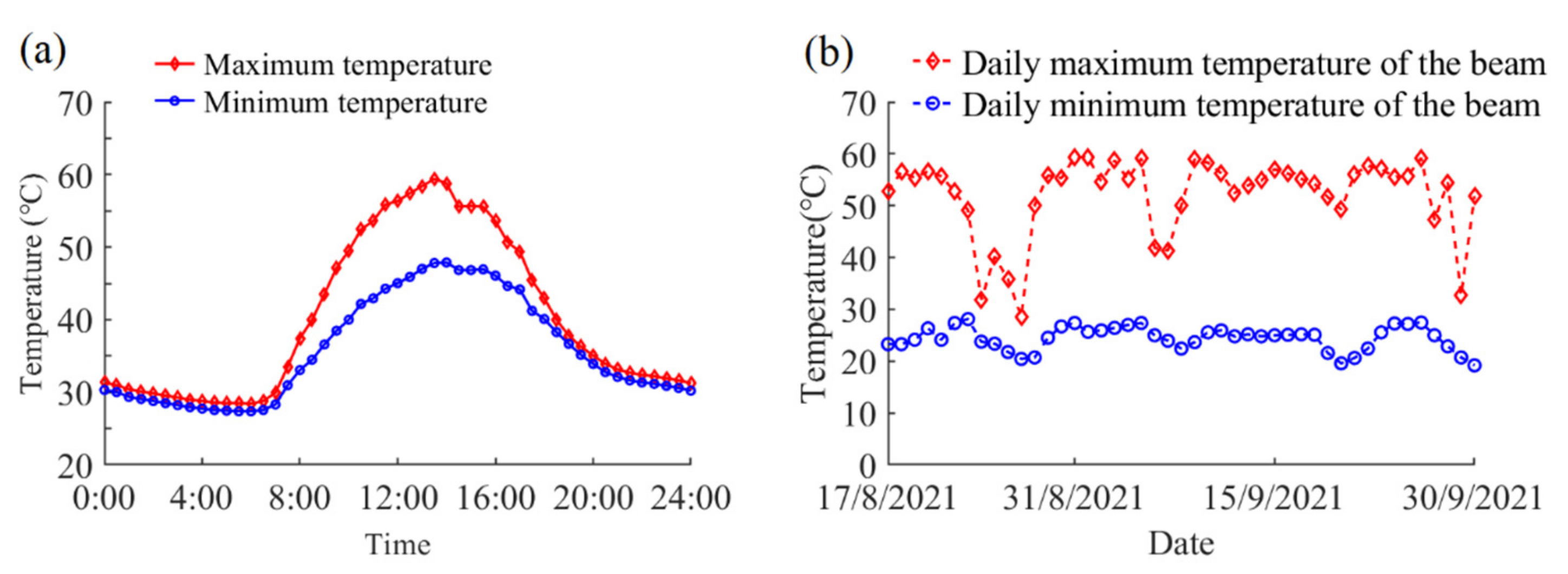


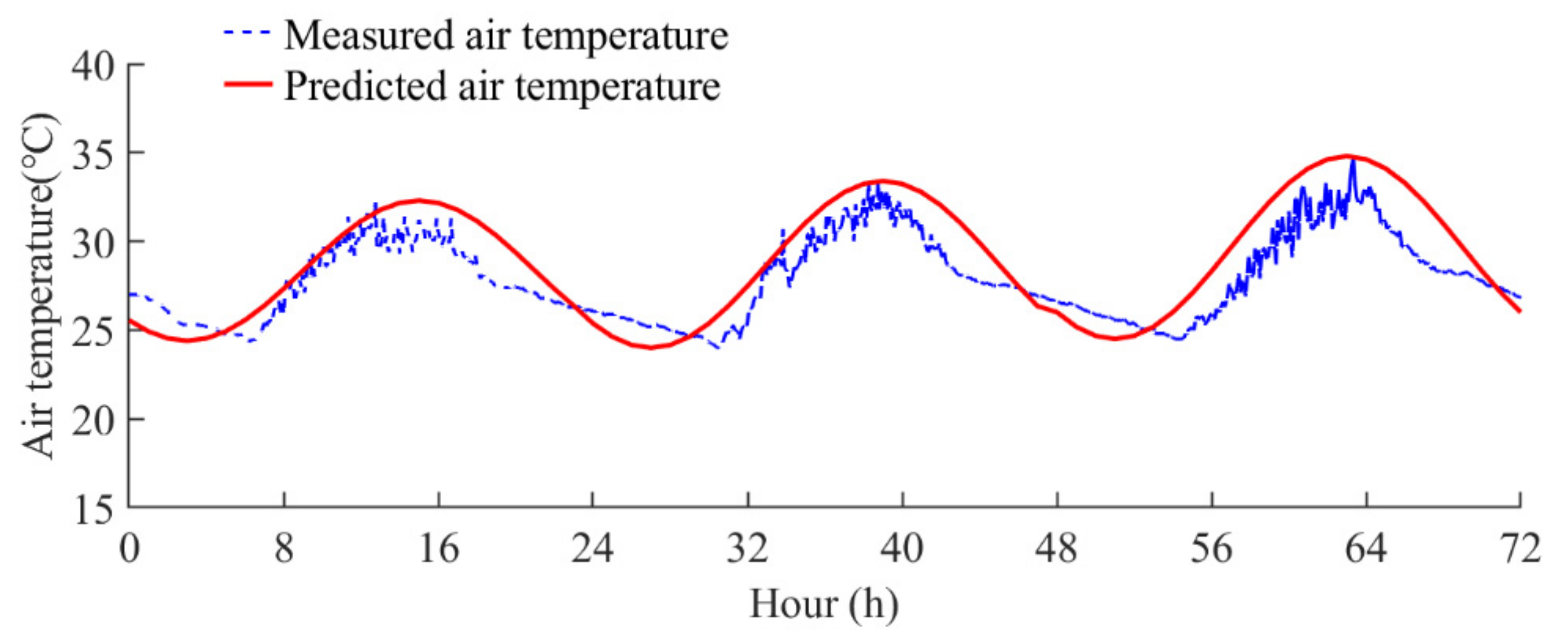
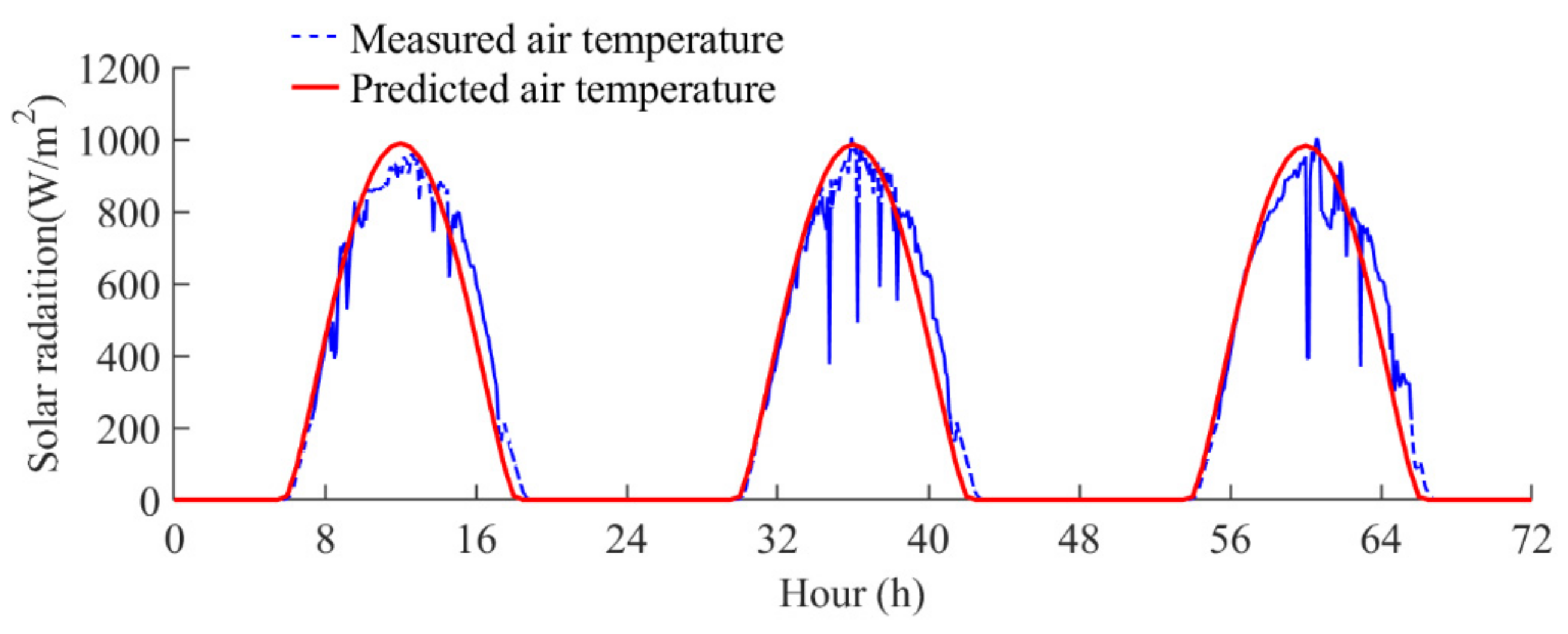
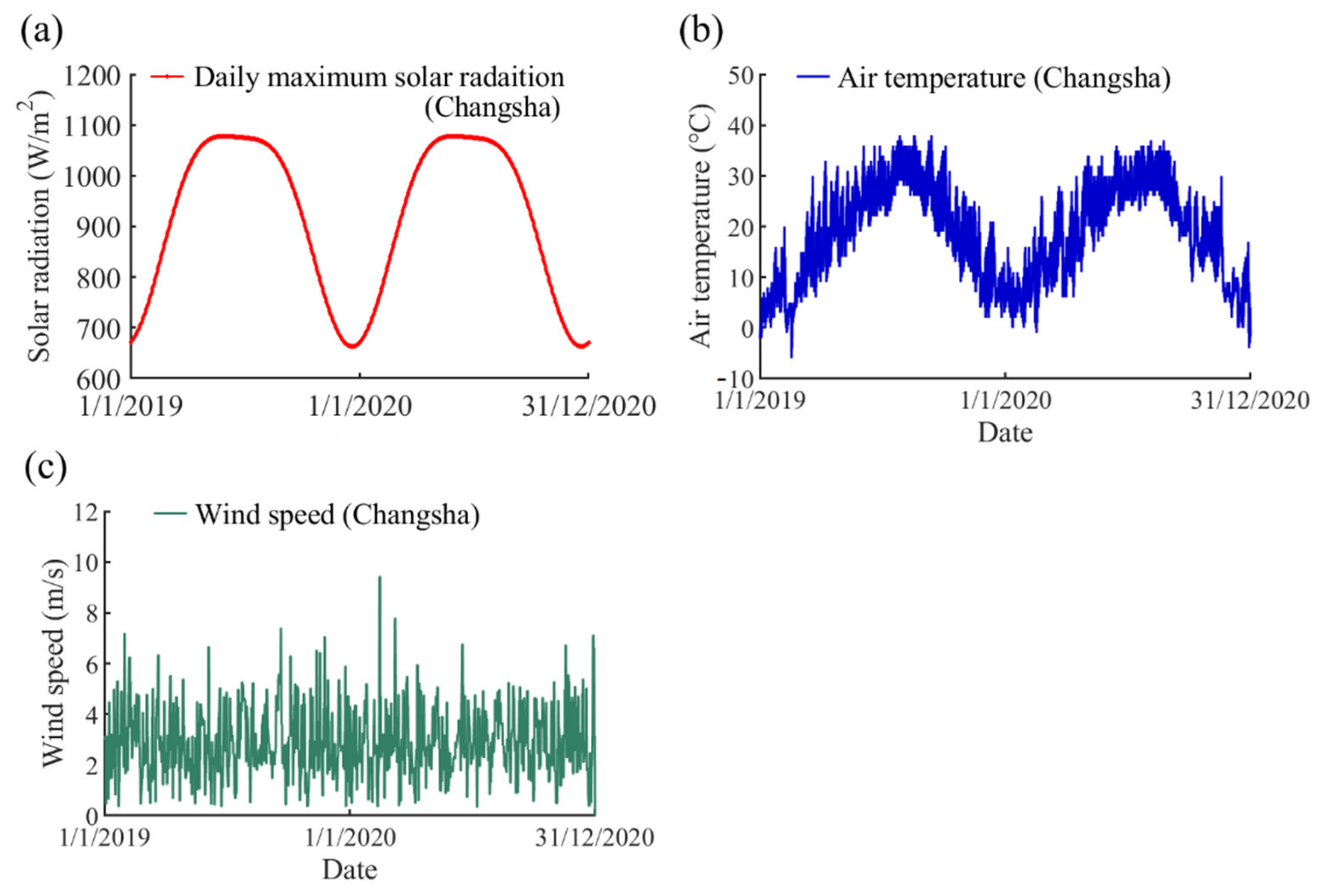
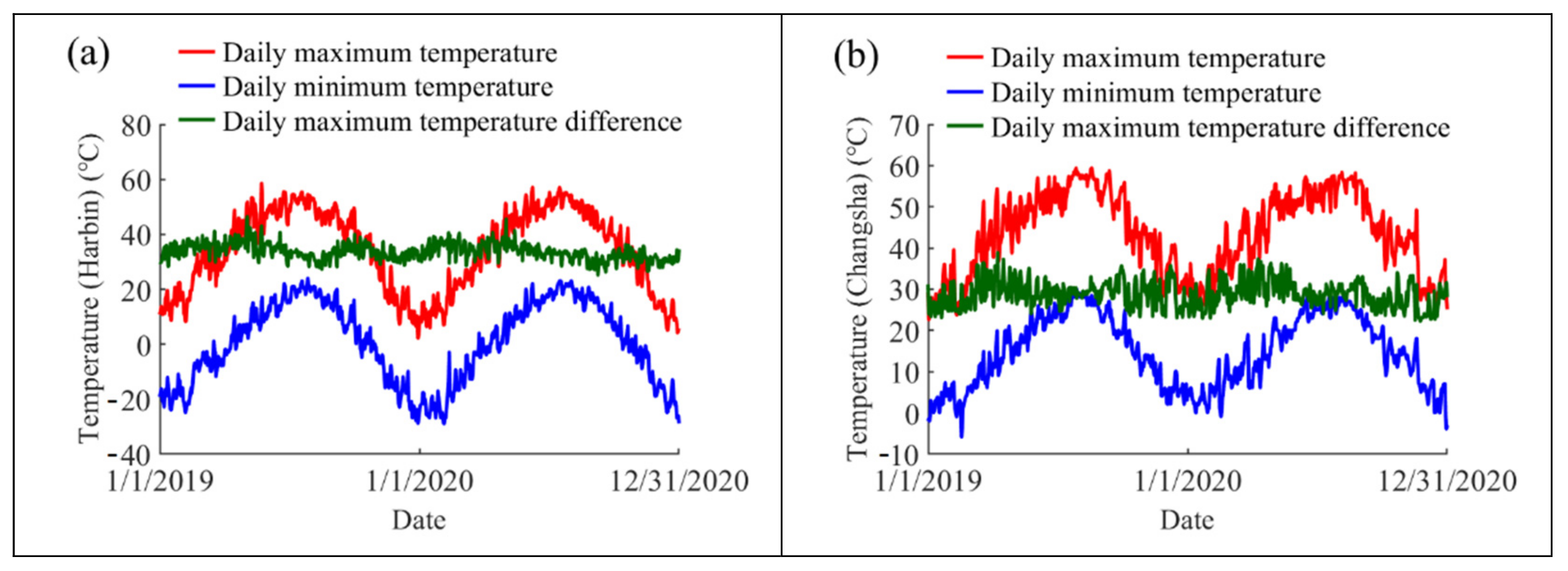



| Thermometer Group | Serial Number | MAE (°C) | AAE (°C) |
|---|---|---|---|
| Section-T | T1 | 3.5 | 1.6 |
| T3 | 3.4 | 0.9 | |
| T4 | 2.8 | 0.9 | |
| Section-M | M2 | 3.8 | 1.5 |
| M5 | 3.2 | 1.0 | |
| M6 | 2.3 | 0.8 | |
| Section-C | C1 | 4.1 | 1.4 |
| C3 | 2.7 | 0.9 | |
| C5 | 3.1 | 0.8 |
| Serial Number | City | Latitude | Longitude | Climatic Type |
|---|---|---|---|---|
| City I | Harbin | 45°44′ N | 126°36′ E | Temperate monsoon climate |
| City II | Changsha | 28°08′ N | 112°59′ N | Subtropical monsoon climate |
| City III | Jinan | 36°40′ N | 117°00′ N | Temperate monsoon climate |
| City IV | Shanghai | 31°14′ N | 121°28′ N | Subtropical monsoon climate |
| City V | Haikou | 20°02′ N | 110°20′ N | Tropical monsoon climate |
| City VI | Kunming | 25°02′ N | 102°43′ N | Subtropical plateau monsoon climate |
| City VII | Naqu | 31°29′ N | 92°04′ N | Plateau mountain climate |
| City VIII | Turpan | 42°55′ N | 89°12′ N | Temperate continental climate |
| City | Maximum Value of Vmax | Minimum Value of Vmin | Maximum Value of Vdiff | |||
|---|---|---|---|---|---|---|
| Value | Date | Value | Date | Value | Date | |
| Harbin | 58.6 °C | 24 May 2019 | −28.9 °C | 5 February 2020 | 46.7 °C | 4 May 2019 |
| Changsha | 59.5 °C | 19 August 2019 | −5.8 °C | 17 February 2019 | 38.9 °C | 9 April 2019 |
| Jinan | 60.6 °C | 4 July 2019 | −11.8 °C | 29 December 2020 | 41.8 °C | 17 May 2020 |
| Shanghai | 55.8 °C | 13 August 2020 | −0.1 °C | 16 February 2020 | 31.6 °C | 9 April 2019 |
| Haikou | 54.2 °C | 17 May 2020 | 11.0 °C | 31 December 2020 | 28.5 °C | 9 March 2020 |
| Kunming | 55.2 °C | 16 May 2019 | −1.9 °C | 25 January 2020 | 42.3 °C | 31 March 2019 |
| Naqu | 40.2 °C | 27 June 2019 | −27.0 °C | 24 January 2020 | 44.3 °C | 28 December 2020 |
| Turpan | 70.1 °C | 3 July 2019 | −13.9 °C | 4 February 2020 | 41.5 °C | 5 June 2020 |
| City | Type of Distribution | Shape Parameter (ξ) | Shape Parameter (σ) | Shape Parameter (μ) | Representative Value |
|---|---|---|---|---|---|
| Harbin | Weibull | −0.1693 | 2.8601 | 32.4923 | 46.9 °C |
| Changsha | Weibull | −0.1983 | 3.0534 | 27.6373 | 40.8 °C |
| Jinan | Weibull | −0.1762 | 2.4145 | 30.2210 | 41.9 °C |
| Shanghai | Weibull | −0.1970 | 2.4095 | 22.8696 | 33.3 °C |
| Haikou | Weibull | −0.3310 | 2.4055 | 21.4412 | 28.8 °C |
| Kunming | Weibull | −0.3570 | 3.2066 | 33.8427 | 42.6 °C |
| Naqu | Weibull | −0.2039 | 2.8739 | 32.0181 | 44.4 °C |
| Turpan | Weibull | −0.3533 | 3.0652 | 33.2078 | 41.7 °C |
Publisher’s Note: MDPI stays neutral with regard to jurisdictional claims in published maps and institutional affiliations. |
© 2022 by the authors. Licensee MDPI, Basel, Switzerland. This article is an open access article distributed under the terms and conditions of the Creative Commons Attribution (CC BY) license (https://creativecommons.org/licenses/by/4.0/).
Share and Cite
Huang, S.; Cai, C.; Zou, Y.; He, X.; Zhou, T. Investigation of Temperature Variations and Extreme Temperature Differences for the Corrugated Web Steel Beams under Solar Radiation. Sensors 2022, 22, 4557. https://doi.org/10.3390/s22124557
Huang S, Cai C, Zou Y, He X, Zhou T. Investigation of Temperature Variations and Extreme Temperature Differences for the Corrugated Web Steel Beams under Solar Radiation. Sensors. 2022; 22(12):4557. https://doi.org/10.3390/s22124557
Chicago/Turabian StyleHuang, Shiji, Chenzhi Cai, Yunfeng Zou, Xuhui He, and Tieming Zhou. 2022. "Investigation of Temperature Variations and Extreme Temperature Differences for the Corrugated Web Steel Beams under Solar Radiation" Sensors 22, no. 12: 4557. https://doi.org/10.3390/s22124557
APA StyleHuang, S., Cai, C., Zou, Y., He, X., & Zhou, T. (2022). Investigation of Temperature Variations and Extreme Temperature Differences for the Corrugated Web Steel Beams under Solar Radiation. Sensors, 22(12), 4557. https://doi.org/10.3390/s22124557






